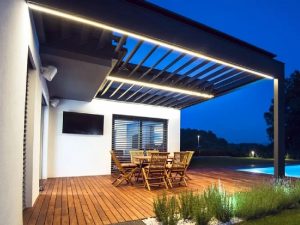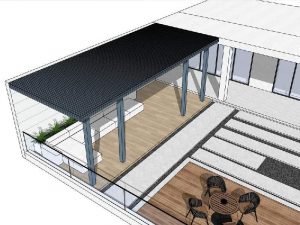As fall deepens across the Northern Hemisphere, the air becomes crisp and the daylight fades earlier each day. Your patio, once the perfect spot for morning coffee or quiet evenings, may now sit untouched as the calm winds move in. When winter arrives, even your favorite outdoor moments often shift back indoors.

It doesn’t have to be that way. With the right patio cover, you can protect your outdoor space from cold air, rain, and early snow. A well-designed cover helps keep your patio clean, dry, and comfortable so you can continue enjoying outdoor living even during colder months.
This guide introduces 15 practical and stylish patio cover ideas for winter, each with pictures for inspiration. From transparent hardtop roofs and aluminum structures to full sunroom-style enclosures, these designs can help you create a warm, weather-resistant retreat right in your backyard.
Before Exploring The Different Patio Cover Ideas
Before exploring the different design ideas, take a moment to think about what you really need from your patio cover. Every home and lifestyle is different. Some people want simple protection from rain and snow, while others look for a permanent structure that blends design and comfort. Understanding your main goal will help you choose a solution that fits your space, budget, and climate.
- Homeowners: Focus on comfort and long-term durability. Look for designs that can handle different seasons, such as aluminum roofs, transparent hardtops, or fully enclosed sunroom-style covers.
- Designers and Builders: Prioritize visual appeal and structure. Glass roofs, pergola-style frames, or louvered systems can complement modern architecture while providing weather protection.
- Budget-Conscious Users: Choose flexible and easy-to-install options. Roll-down curtains, vinyl enclosures, or fabric canopy designs can offer warmth and shelter without significant renovation costs.
- All-Season Outdoor Lovers: Look for systems that balance insulation, strength, and ventilation. Louvered roofs or smart motorized covers are ideal for those who want to enjoy their patio year-round.
If you want to learn more about the different patio cover materials, styles, and price ranges, visit our detailed guide:
What Is a Patio Cover? Types, Materials & Costs.
1. Transparent Hardtop Patio Cover
A transparent hardtop patio cover made from polycarbonate panels or double-layer tempered glass allows sunlight to filter through while keeping your patio protected from snow and rain. It gives your outdoor space a clean and modern look while keeping the area dry and bright throughout the winter.
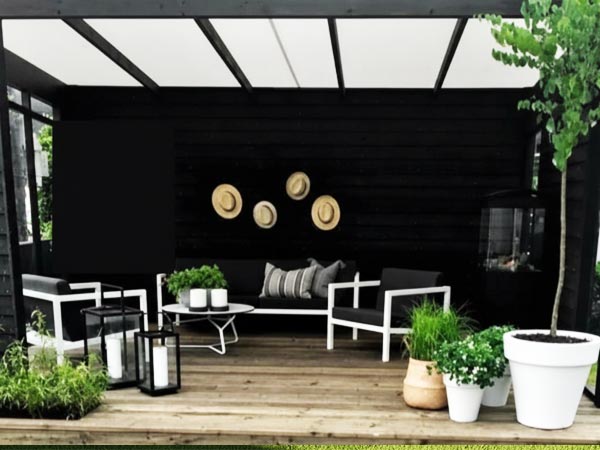
Polycarbonate and glass are both durable and long-lasting materials. Glass offers a more premium appearance but is more expensive and heavier. Polycarbonate panels are lighter and more flexible but may need occasional maintenance after long-term sun exposure. For warmer months, you can pair this structure with a retractable shade to control sunlight and temperature. If you want a sturdy roof that looks elegant and performs well during winter, a transparent hardtop patio cover is a safe and timeless choice.
2. Pergola-Style Patio Cover with Transparent Roof
In many modern homes, pergolas are no longer just open wooden frames. Adding a transparent roof panel to a pergola creates a perfect balance between openness and protection. This hybrid design keeps the airy feeling of a pergola while shielding your patio from wind, rain, and snow.
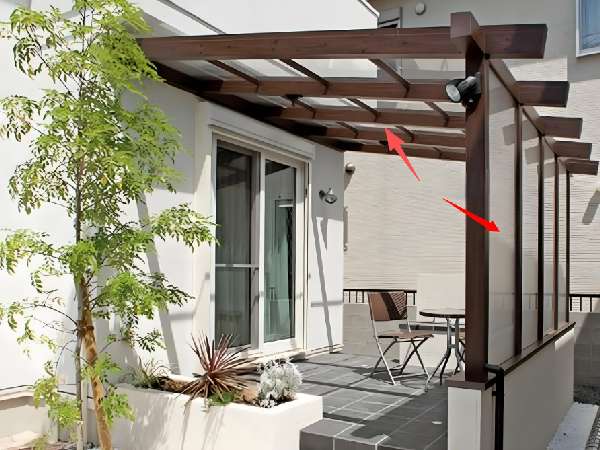
Its key advantage is the natural light and visual connection to the outdoors. However, insulation is less effective than in fully enclosed designs, so it may not be ideal for extremely cold climates. To manage sunlight during summer, consider adding a fabric shade or roll-down screen. If you prefer a stylish look and want to enjoy the sunlight during cooler months, a pergola-style patio cover with a transparent roof can be an excellent option.
3. Aluminum Patio Cover with Gutter System
For homeowners seeking a strong, low-maintenance structure, an aluminum patio cover with a gutter system is one of the most practical solutions. The full-metal frame provides excellent stability and weather resistance, easily handling winter rain or snow. The built-in gutters efficiently drain water and melting snow, keeping the patio floor dry and clean.
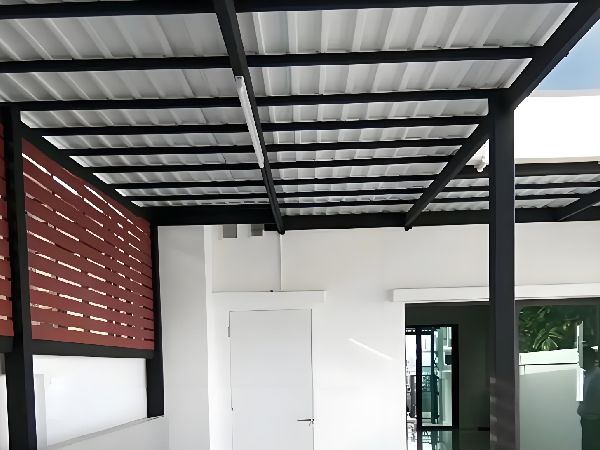
Aluminum is corrosion-resistant and requires minimal maintenance, making it a long-term investment. Its appearance is more functional than decorative, but it can be powder-coated in neutral colors to match your home. While it may not offer the natural warmth of wood or the openness of glass, it performs exceptionally well year-round. If you need a durable, all-weather solution that requires little maintenance, an aluminum patio cover with a gutter system is a smart choice.
4. Vinyl Patio Enclosure Curtains
If you want to keep your patio warm and protected in winter without building a permanent structure, vinyl enclosure curtains are an innovative and flexible option. These clear PVC or vinyl panels can be rolled down to block wind and rain, turning an open patio into a cozy enclosed space within minutes.
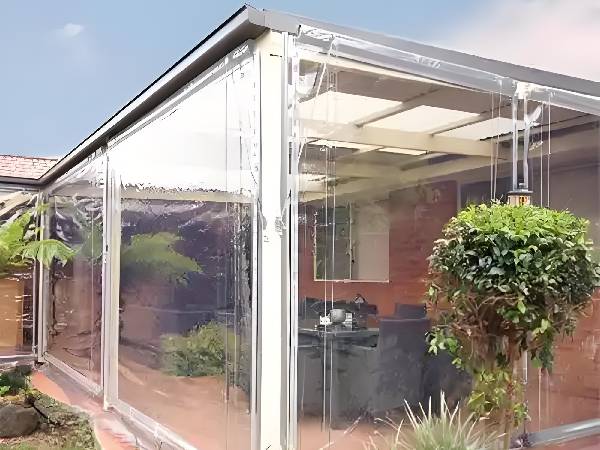
Vinyl curtains are affordable, easy to install, and work well for seasonal use. They maintain visibility and let natural light through, keeping the area bright and open. However, their insulation is limited, and strong winds or frost can make the material stiff or foggy. Regular cleaning is needed to maintain clarity. If you are looking for a cost-effective and straightforward way to keep your patio usable during cold weather, vinyl enclosure curtains are a great solution.
5. Roll-Down Clear or Shaded Screens
Roll-down patio screens offer a modern way to control both light and wind. Depending on the material you choose, they can provide varying levels of visibility, shade, and insulation. Transparent TPU or PVC screens maintain full outdoor visibility, while semi-transparent fabrics such as Textilene or HDPE balance privacy and sunlight. UV-blocking shaded screens are better for year-round use, offering both comfort and protection.

These screens can be operated manually or by motorized systems, making them convenient and adaptable. They are ideal for homeowners who want flexibility between open-air and enclosed patio use. The main downsides are cost and maintenance, as the rolling mechanism requires occasional servicing. Still, for a stylish, adjustable, and practical solution, roll-down screens are a perfect blend of design and function.
6. Full Enclosed Sunroom-Style Cover
For those who want to enjoy their patio year-round, a sunroom-style enclosure offers the highest level of comfort and protection. This design transforms your patio from a semi-outdoor space into a true indoor extension. With a solid roof and fully enclosed glass or polycarbonate walls, it keeps out cold air, snow, and noise while letting in plenty of natural light.
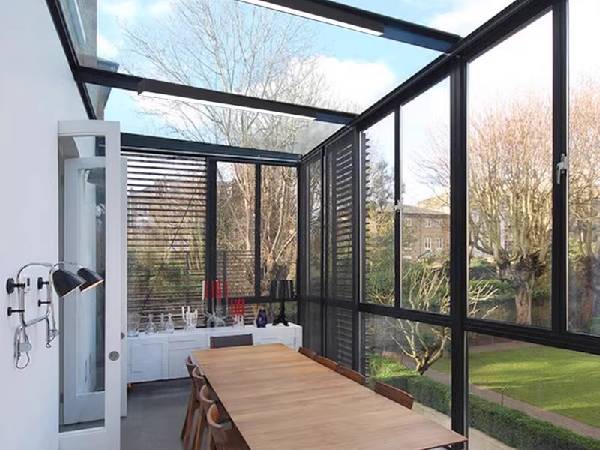
A sunroom cover lets you use the space for relaxing, reading, or even as a small winter greenhouse for plants. It provides excellent insulation and weather resistance, but requires a higher investment and usually a building permit. Construction takes longer and requires more planning than for lighter structures. If you want your patio to become a year-round living area, a fully enclosed sunroom-style cover is the most complete and durable option.
7. Retractable Awning with Side Panels
A retractable awning with side panels is a practical choice for homeowners in mild climates or those who prefer a flexible shade solution. This setup allows you to extend the awning for protection during rain or wind and retract it on sunny days to enjoy open skies. The added side panels provide extra shelter from cold air, turning the space into a semi-enclosed retreat during cooler months.
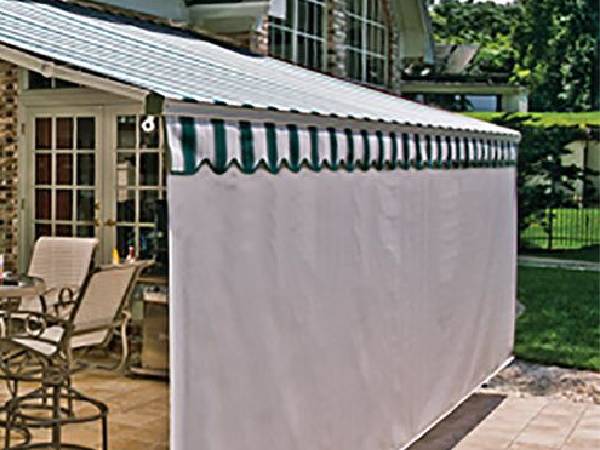
This type of patio cover is budget-friendly, space-saving, and easy to operate. However, it offers limited wind and snow resistance, so the fabric should be retracted during intense storms or heavy snowfall. Regular maintenance of the fabric and frame is also essential for longevity. If you want a seasonal solution that adapts to different weather conditions, a retractable awning with side panels is a flexible and elegant option.
8. Freestanding Canopy
A freestanding canopy provides shade and shelter without attaching the structure to your home. It is lightweight, easy to install, and can be moved or stored as seasons change. This makes it ideal for homeowners who want a temporary or portable cover that can still provide comfort and protection during the cooler months.
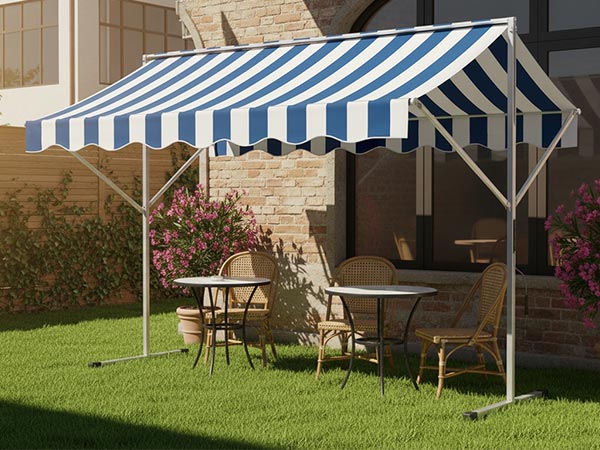
While the structure is simple and versatile, its wind and snow resistance are limited. The fabric may wear out faster in cold or windy environments, so it works best in mild climates such as the southern or coastal regions of the United States. If you are looking for a non-permanent patio cover that offers flexibility and quick setup, a freestanding canopy is an excellent choice.
9. Hardtop Gazebo with Curtains or Screens
A hardtop gazebo is a strong and visually appealing structure that can transform your patio or backyard into an actual outdoor living room. Made from aluminum, steel, or polycarbonate panels, it provides solid protection from snow, wind, and rain. When paired with curtains or retractable screens, it can create a private, cozy space for winter gatherings.
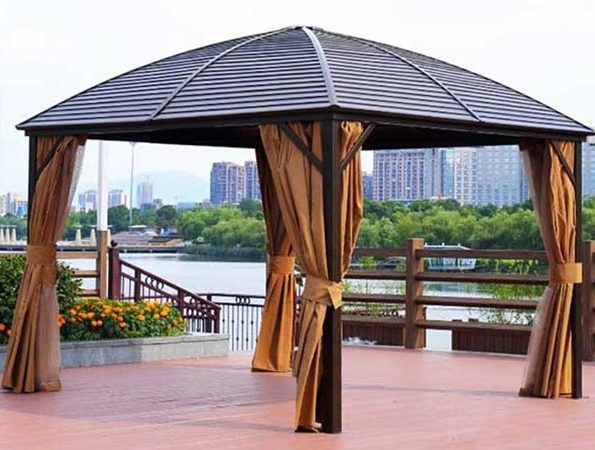
This type of structure is more expensive and requires professional installation, but it offers superior durability and weather resistance. A hardtop gazebo is ideal for spacious patios or gardens where you want both functionality and design impact. If you are planning to create a comfortable, elegant outdoor lounge that can be used year-round, a hardtop gazebo is a reliable and stylish option.
10. Add Heaters or a Fire Pit
Adding heating elements to your patio cover setup can make your outdoor space more enjoyable during cold weather. Electric patio heaters, infrared panels, or a built-in fire pit can provide consistent warmth so you can continue relaxing or entertaining outside even in winter. A combination of overhead and ground-level heating works best for larger patios or semi-enclosed areas.
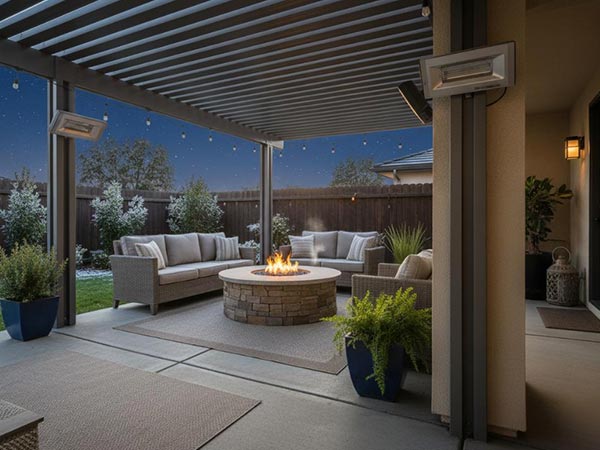
When installing electric heaters, make sure all wiring is rated for outdoor use and kept away from moisture. Fire pits should always be used with proper ventilation and in accordance with local safety regulations. While heaters increase comfort, they also raise energy costs, so consider energy-efficient models or programmable timers. If your goal is to make your patio cozy without significant structural changes, adding heating equipment is an easy and effective upgrade.
11. Louvered Roof Patio Cover
A louvered roof patio cover offers one of the most versatile and high-end solutions for year-round outdoor living. The adjustable aluminum slats can tilt open to let in sunlight or close completely to block rain and snow. This system gives you full control over light, airflow, and protection, making it ideal for climates with changing weather conditions.

When closed, most louvered roofs feature integrated gutters to efficiently channel rainwater. They are durable, sleek, and modern but tend to cost more than standard fixed covers. Motorized versions add even greater convenience. If you want a patio cover that adapts to all seasons and delivers a premium appearance, a louvered roof system is a smart investment.
12. Integrated Drainage and Snow-Load Roof System
For homeowners in regions with heavy snow or frequent rain, choosing a patio cover designed for high snow-load capacity and integrated drainage is essential. These systems use reinforced aluminum or steel framing combined with built-in gutters to efficiently drain water and melted snow, reducing pressure on the roof.

This type of cover provides reliable year-round performance with minimal maintenance. It is especially suitable for northern U.S. regions or mountain areas where winter weather can be harsh. Although construction costs are higher, the durability and safety benefits make it a worthwhile investment. If you want a strong, worry-free patio structure that can withstand harsh climates, a snow-load-rated roof system is the best choice.
13. Smart Motorized Patio Cover
Technology is becoming an essential part of modern outdoor living. A smart motorized patio cover lets you control the roof or side screens with the touch of a button, or automatically via weather sensors. When it starts raining or snowing, the system can close automatically to keep your patio dry and protected.
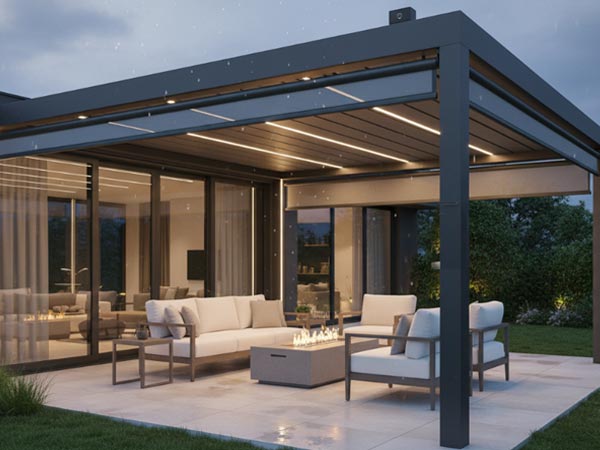
These covers offer excellent convenience and safety, especially in areas with unpredictable weather. They can be connected to smart home systems and controlled by remote or mobile apps. The main considerations are cost and maintenance, as motorized components require occasional servicing. If you want an advanced solution that blends comfort, design, and automation, a smart patio cover is an impressive upgrade for any home.
14. Fabric-Sail Canopy
A fabric-sail canopy is a lightweight and visually appealing option that provides partial shade and weather protection. Made from durable outdoor fabrics such as HDPE or polyester canvas, it can be installed with tensioned cables or poles to create a modern and airy look. This setup works especially well for patios in regions with mild winters or limited snowfall.
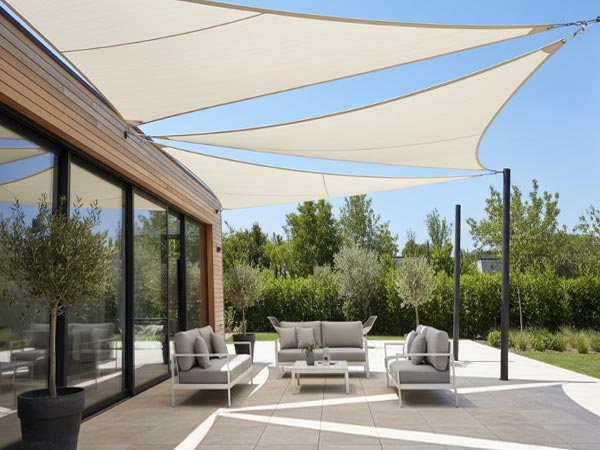
While not suitable for heavy snow or strong wind, a shade sail is easy to remove, adjust, or replace when needed. It is a cost-effective way to add seasonal shelter without major construction work. If you prefer a simple, stylish patio cover that adapts to different seasons, a fabric-sail canopy offers flexibility and charm at an affordable price.
15. Green Patio Cover with Vertical Plants
Image: Patio cover design integrated with climbing plants and vertical greenery
Incorporating plants into your patio cover design adds natural warmth and visual appeal to your outdoor area. Vertical greenery or climbing plants can grow along pergola frames or lattice walls, creating a living shade that changes beautifully through the seasons. This concept is gaining popularity among homeowners who want to combine sustainability with design aesthetics.
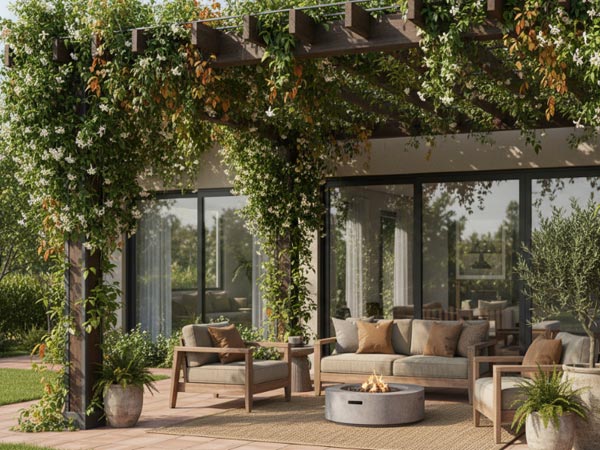
For colder climates, choose evergreen or frost-resistant plants, or use planters that can be moved indoors during winter. Maintenance is required, but the result is a refreshing and organic space that enhances both comfort and privacy. If you enjoy a more natural, decorative patio environment, integrating greenery into your patio cover is a creative, timeless idea.
Frequently Asked Questions (FAQ)
1. What is the best patio cover for winter?
The best patio cover for winter depends on your climate and budget. In snowy or cold regions, aluminum patio covers and full sunroom-style enclosures offer the strongest protection. For milder weather, louvered roofs or pergola-style covers with transparent panels can provide light, warmth, and comfort while keeping the area dry.
2. Can a patio cover withstand heavy snow?
Yes. Many aluminum and polycarbonate roof systems are designed for high snow loads. To ensure safety, choose a structure with reinforced framing and proper drainage. Regularly clearing snow from the roof will also help prevent excessive weight buildup.
3. How much does a patio cover cost?
Patio cover prices vary widely depending on materials and design. A basic fabric or vinyl option may cost several hundred dollars, while a fully enclosed glass or aluminum structure can exceed $30,000. You can estimate your specific budget using our Patio Cover Cost Calculator.
4. What materials work best for year-round use?
Aluminum and polycarbonate are ideal for all-season patio covers. Aluminum offers excellent strength and low maintenance, while polycarbonate panels provide natural light and UV protection. To compare the pros and cons of materials, visit our guide, “What Is a Patio Cover?“ Types, Materials & Costs.
5. Do I need a permit to build a patio cover?
In most U.S. cities and counties, permanent patio covers or sunroom-style enclosures require a local building permit. Rules vary by location, so it is always best to check with your local building department or consult a licensed contractor before starting construction.
6. How can I maintain my patio cover during winter?
To keep your patio cover in good condition, clean gutters and roof panels regularly, remove snow buildup, and check for loose screws or seals. For motorized or retractable systems, inspect moving parts and lubricate them as needed. Simple maintenance can greatly extend the life of your structure.
Conclusion
As the colder months settle in, it is easy to forget how much joy your patio can bring. With the right design, materials, and protection, your outdoor space can remain a warm and inviting part of your home all winter long. From simple fabric canopies to advanced smart covers, each idea offers a unique way to extend the comfort of indoor living into the outdoors.
When choosing a patio cover, think about how you want to use your space, how much light and shelter you need, and what fits your lifestyle. A well-planned design will not only protect your patio but also redefine your winter experience at home.
Which of these patio cover ideas for winter do you think would work best for your home? Share your thoughts or favorite design with friends, or let us know what inspires you most. If you are planning a new project and need guidance, our team at LIDA OUTDOOR can help you find the perfect solution for your space.

